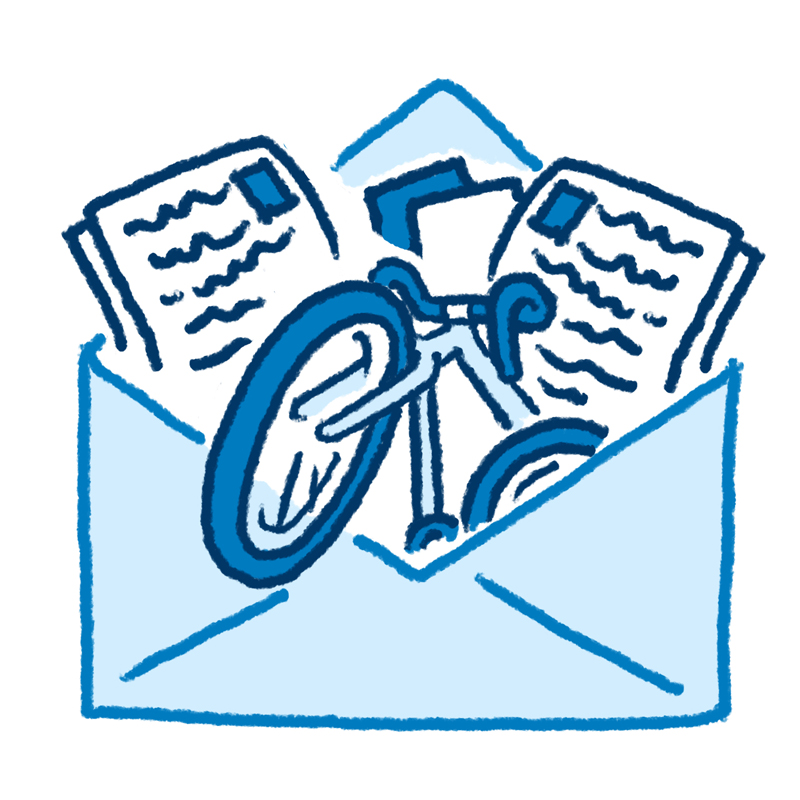Training for Your Bikepacking Trip
Photo by Mike Lessard
Simply put, bikepacking is more fun when mind and body are on the same team. Many a long bike ride has begun with no training at all, and we’re not here to discourage anyone from trying if that’s your style. But there is freedom in feeling like your body is helping you cover the miles instead of complaining about them.
Build a Base by Riding Often
If you’re new to cycling or haven’t ridden much lately, start by simply riding as much as possible: to the store, to work, to the park on Saturday afternoon. Even indoor trainers count, though try to ride outside as much as you can. Ideally, begin this phase a few months before a big trip so you have time for more specific training later.
Use this time to let your body and bike get used to each other. Make sure your saddle is comfortable or try a different one. Dial in its position and height using an online guide or the help of a local bike shop. Ride with a multitool and make adjustments on the fly, noting how they affect your posture and comfort.
Cycling Form Tips
Now is the time to build efficient pedaling habits. Think about pedaling in a circular motion and applying force throughout the entire stroke instead of just pushing downward. When you feel yourself working hard to keep the pedals moving, shift to an easier gear so you can spin the pedals faster with less resistance.
Remind yourself to engage your core muscles — think about pulling your bellybutton inward toward your spine — to keep your upper body stable and hands light on the bars. When riding for many hours at a time, these good habits can help prevent everything from achy knees to saddle sores to numb hands.
Build Endurance by Riding Longer
Once it feels normal to hop on your bike a few times a week, extend one of those weekly rides to a few hours. These rides are about finding a slow and steady “all day” pace, so measure by time rather than miles, and ride slowly enough that you can comfortably converse. If you’re inclined to be organized with your training, increase the length of these rides by around 10% each week. A long ride of five to six hours would be a great goal.
Long rides are a good time to practice bikepacking-specific skills that might be new to you, like creating a GPX track for a new route and using a smartphone app to follow it. If the thought of fixing a flat by the side of the road fills you with dread, now’s the time to watch some how-to videos and pack a patch kit, spare tube, and mini-pump (and tubeless repair supplies, if needed).
As you work up to longer rides you might experience mild knee soreness, cranky shoulder and back muscles, and some saddle-area tenderness. These should improve after a few long rides followed by rest days. If they don’t or if they’re particularly intense, try adjusting your seat position, handlebar height, or saddle choice, or visit a local bike shop for advice.
Build Skills on Specific Terrain
If you’re a mountain biker who rides technical trails for fun, you can skip this section. For the rest of us, especially if we live in an urban area, it can be hard to find nearby terrain resembling what we’ll find on a bikepacking trip. This isn’t the end of the world, but do try to get in at least one longer ride on bikepacking-specific terrain during the last few weeks before a trip. Bonus points if you can do it with a loaded bike.
Most importantly, consider your route’s elevation profile and look for the closest approximation you can find in your area. If you live in the flatlands but want to bikepack in the mountains, you might need to train by riding repeats up and down the only hill in your county. Next, consider your route’s surface. Bikes handle very differently on different surfaces, and your body will learn the necessary responses with practice.
Technical Riding Tips for Beginners
Riding trails and chunky jeep tracks can feel like an entirely different sport from cruising pavement. If you find yourself on more technical terrain than you’re used to, try these tips to adjust your riding style:
Put more weight in your legs and less on your saddle. Think about actively shifting your weight to keep your body balanced around the bike, and your bike-body unit balanced relative to the terrain.
Think of lowering your center of gravity, sitting more “in” the bike than “on top of” it. On more technical terrain, lower your saddle and let your heels drop downward on the pedals to give you more leverage for weight shifts.
On descents shift your weight back and down to keep your rear wheel heavy. On climbs shift weight forward to help your front wheel grip the ground.
On rolling terrain, try to make the most of momentum as you transition from down to up, and don’t forget to use your full range of gears when needed.
Keep your hands light on the bars by using core strength, and relax your arms to absorb bumps. You may not feel like it while hurtling downhill, but it’s possible to squeeze brake levers while keeping arms loose.
Look ahead at where you want to go. Fixating on obstacles is a great way to make sure you ride straight toward them.
Let some air out of your tires for a smoother ride on rough surfaces. Don’t overdo it though, or you’ll risk a pinch flat if the rim comes into contact with the ground. Tubeless tires can be run at lower pressure than tubes.
When in doubt, get off and walk! No sense wasting energy you’ll need later in the day when you could walk a steep or loose section much more efficiently.
Strength, Mobility, and General Fitness
Riding your bike is certainly the best way to train for bikepacking, but supplementing with a general fitness routine will amplify the benefits of riding and keep your body balanced and injury-free.
Strength training helps us pedal up a steep hill, feel less sore after a long ride, and avoid tweaking a knee or straining a muscle. Whether it’s heavy deadlifts with a trainer in the gym or resistance band exercises with online videos in your living room, a session or two of strength training each week can have huge benefits.
Bikepacking — especially on rugged terrain — is actually a full-body activity. Here’s how to think about dividing up your strength workouts:
Lower body and glutes
Sitting in a chair all day — or on a bike — weakens our glutes and hamstrings. This limits our full-body strength and makes us vulnerable to knee injuries and other problems. Balance out all that sitting with exercises like glute bridges, resistance band side-steps, quadruped kickbacks, and deadlifts.
Core
This isn’t about sixpacks but about the deep muscles that support the spine and stabilize the pelvis while our legs pedal in circles. Try exercises like planks, deadbugs, and of course the aptly named “bicycle” to accelerate your progress, or look into core-focused movement systems like pilates or yoga. To cue the right muscles, think about pulling your belly button toward your spine and flattening your lower back during every exercise.
Upper body
New cyclists are often surprised by how sore their back and shoulder muscles feel after a few hours in the saddle. These muscles work hard to stabilize us while riding, so prepare them with exercises like tricep kickbacks, overhead presses, pushups, rows, and lateral straight-arm raises.
Mobility
As we get stronger, we also tend to get tighter. Mobility work helps us maintain our natural range of motion, which is important for injury prevention and riding comfort. Practices like dynamic stretching and yoga can improve mobility, strength, and coordination all at the same time.
General fitness
Cycling is one way to build fitness, but anything that raises your heart rate and gets your body moving will help: running, hiking, swimming, dancing, climbing, tennis…. Long and slow activities like hiking are great for building endurance, while more intense bursts like running hill repeats or playing soccer will help with hill climbs and make a moderate pace feel easier.
Other Factors
Altitude
At higher elevations air pressure is lower, so we get less oxygen with each breath. If you’ll be bikepacking above 6,000 feet, expect to feel more winded than usual while climbing or riding hard. Some people experience minor headaches or a bit of nausea, especially above 9,000 feet or so. Serious altitude sickness is rare, but if you develop a wet cough, severe headache or nausea, or confusion and disorientation, descend to lower elevation right away.
High altitude is notoriously hard to train for. Even people with a high aerobic capacity feel the effects, and adaptations fade quickly once you return to lower elevation. If you can, spend a few days at higher elevation immediately before your ride to give your body a head start at adapting. If that’s not possible, or even if it is, give yourself extra headroom by focusing on high intensity cardiovascular work in your training — think fast running, uphill hiking, HIIT sessions, or heavy weightlifting.
Heat and Humidity
Riding in hot weather makes everything harder. You’ll need to carry more water, monitor your effort level, and take care to avoid dehydration. A typical cycling pace on flats and downhills will generate a cooling breeze, but slow climbs in hot weather can be brutal.
Prepare for heat — and humidity, which makes heat feel even hotter — by training in hot weather if you can. If you live somewhere cold, consider a few indoor training rides or treadmill runs in a hot room during the last couple weeks before your trip.
Conclusion
Whatever you do, don’t let the lack of a perfectly executed training plan stop you from going bikepacking. You might be surprised by how often the mood of a trip comes down to mental factors like adaptability and teamwork. Training is helpful, but it’s just one piece of the puzzle.
Up Next: Safety Concerns


